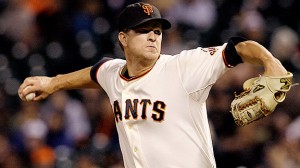BY MATT DeFAVERI
Whenever the New York Yankees play their final game of the season this fall, don’t be alarmed by any sudden gale force winds threatening to blow you off your feet. That’s just every batter’s collective sigh of relief at Mariano Rivera’s official retirement from the game.
Rivera’s already cemented his status as a baseball legend, and his performance this season has so far been one for the ages. He’s converted all 18 of his save opportunities, posted a 1.40 ERA and fanned 16 batters in 19.1 innings of work. I still stand by my previous stance on Rivera’s place below Gossage, but no one is doubting that Rivera, 43, is throwing one hell of a good-bye party this year.
As Rivera departs, so does that glorious cutter of his, but will – or can – baseball ever see a cutter as good as Mo’s again?
Back to basics
The motion of throwing a cutter is like turning a doorknob – the index and middle finger sit together, off-center of the ball, and when the wrist snaps down the top two fingers follow in a slightly curved arc. The action creates a spinning motion that, for a right-handed pitcher like Rivera, runs in on left-handed batters and away from right-handed batters.
“The cutter varies per individual quality of the pitch, the comfort level with throwing it and usability,” said Lee MacPhail IV, a major league scout for the Seattle Mariners. “Essentially, as ‘old-time’ baseball people will tell you, it’s actually just a slider. You can use it in a multitude of ways like other pitches in terms of opening up the zone.”
The cutter’s movement is later than a slider, though not quite as abrupt, MacPhail said.
According to FanGraph’s PITCH f/x information, Rivera’s thrown 3,205 cutters since the tool started tracking individual pitches in 2007.
Opposing hitters have a .185 BA against Rivera’s cutter. The pitch produces a ground ball 49.7% of the time and a fly ball 33.2% of the time (not necessarily outs). Rivera’s thrown 2,212 cutters for strikes and just 993 for balls.
By comparison, Boston Red Sox starter Jon Lester has thrown 3,138 cutters since the 2007 season. Opponents hit Lester’s cutter at a .211 clip. His pitch produces a ground ball 49.8% of the time and a fly ball 29.5% of the time. He’s thrown his cutter 2,316 times for strikes and 1,002 times for balls.
Considering Lester’s a starting pitcher, those comps are insane.
One trick pony
Baseball’s a game of adaptation, though Rivera hasn’t exactly conformed to that idea over his career. Over seven seasons, Rivera’s thrown his cutter almost 3 times more than his four-seam or two-seam fastball, yet opponents have steadily hit his cutter less and less over the last three years.
Batters hit Rivera’s cutter at a .214 clip in 2011, a .207 clip in 2012 and a paltry .145 clip so far this season.
Before that, batters had a .250 BA in 2007, a .183 BA in 2008 and a .158 BA in 2009 against Rivera’s cutter.
The search for the next great cutter might prove fruitful or may lead to disappointment, but MacPhail knows what he’s looking for in the pitch.
“It’s really the lateness in the zone and the action and the deception and the firmness of it, those last 5 feet [to the plate] and ability to deceive the hitter and disrupt his timing,” MacPhail said. “Does the guy have the ability to throw it to both sides? Is it a strike? Is it a quality strike? Is it reliable, dependable?”
Rivera’s cutter has been so effective because hitters can’t time the late movement, said MacPhail, adding, “the deception with the arm path and the delivery and the lateness of the pitch all combine together” to make Rivera’s cutter devastating.
A time for trends
Rivera wasn’t the first pitcher to throw a cutter when he entered the majors in 1995, but the way he threw it was “unique and at a different level,” Macphail said. “He’s a freak of nature. He really is.”
Sometimes certain pitches come in waves, submerging and resurfacing years later. MacPhail pointed to certain trends like Bruce Sutter and Jeff Morris with the forkball.
“This was a short term process, but Bruce had one of the best forkballs I’ve ever seen,” MacPhail said. “[Sutter and Morris] started throwing the forkball and for about 10, 15 years, you didn’t really see many good ones anymore. Hitters laid off of it, they recognize it.”
As for Rivera’s cutter, MacPhail said he’d be hard-pressed to say if baseball would ever see another cutter like it.
“Will we? Could we? Yeah, sure,” he said. “I can’t say it’ll definitely happen, but I’d like to be around to see it. [Rivera’s] unbelievable. He’s a freak. This guy’s probably lived at least three generations beyond the shelf life of most closers. … Whether we’ll ever see another guy like him, it’s hard to say.”
Whatever happens, Rivera’s wheeled and dealed his way to an incredible first two months of his final season in the game. Let’s all enjoy the ride and be thankful for the opportunity to see him pitch one last season.
Comments? Leave them in the comment section below or e-mail the author at mattdefaveri@gmail.com.
























